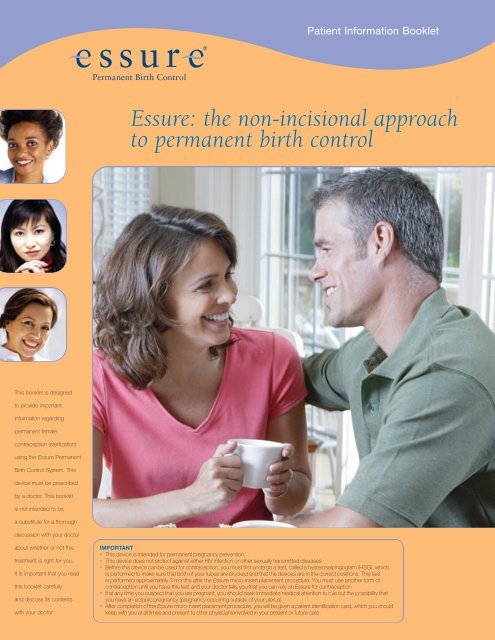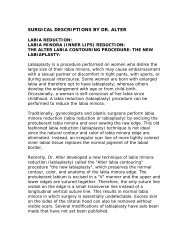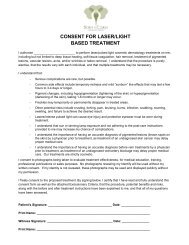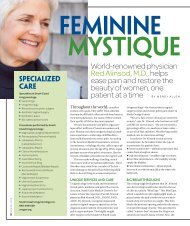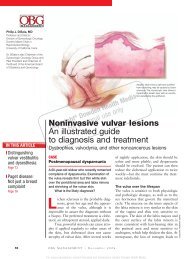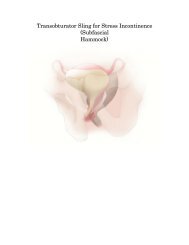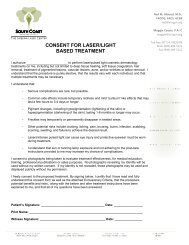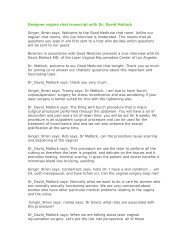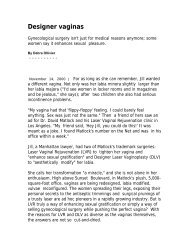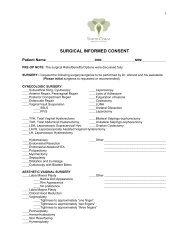Patient-Information-Booklet-ENG - Urogyn.org
Patient-Information-Booklet-ENG - Urogyn.org
Patient-Information-Booklet-ENG - Urogyn.org
- No tags were found...
Create successful ePaper yourself
Turn your PDF publications into a flip-book with our unique Google optimized e-Paper software.
<strong>Patient</strong> <strong>Information</strong> <strong>Booklet</strong>Essure: the non-incisional approachto permanent birth controlThis booklet is designedto provide importantinformation regardingpermanent femalecontraception (sterilization)using the Essure PermanentBirth Control System. Thisdevice must be prescribedby a doctor. This bookletis not intended to bea substitute for a thoroughdiscussion with your doctorabout whether or not thistreatment is right for you.It is important that you readthis booklet carefullyand discuss its contentswith your doctor.IMPORTANT• This device is intended for permanent pregnancy prevention• This device does not protect against either HIV infection or other sexually transmitted diseases• Before this device can be used for contraception, you must first undergo a test, called a hysterosalpingogram (HSG), whichis performed to make sure that both of your tubes are blocked and that the devices are in the correct positions. This testis performed approximately 3 months after the Essure micro-insert placement procedure. You must use another form ofcontraception until you have this test and your doctor tells you that you can rely on Essure for contraception• If at any time you suspect that you are pregnant, you should seek immediate medical attention to rule out the possibility thatyou have an ectopic pregnancy (pregnancy occurring outside of your uterus)• After completion of the Essure micro-insert placement procedure, you will be given a patient identification card, which you shouldkeep with you at all times and present to other physicians involved in your present or future care
Glossary ......................................................................................................... 3Introducing Essure ® ....................................................................................... 4What are the benefits of Essure?..................................................................... 5The Essure procedure: key risks and considerations ........................................ 6Is Essure right for you? .................................................................................. 8Risks............................................................................................................. 14How is the Essure procedure performed? ...................................................... 182
Anesthesia—Medically induced partial or complete loss of sensation, in all or part of the body,with or without loss of consciousness. General anesthesia is total loss of consciousness and sensationCervix—The passageway that connects the vagina to the uterusContraceptive—Any process, device, or method that reduces the likelihood of pregnancyDelivery Catheter—A long tube-like device that helps the doctor place the Essure micro-insertsin the fallopian tubesEctopic Pregnancy—The development of a fertilized egg outside of the uterus, but inside the bodyExpulsion—Forcing (expelling) something outFallopian Tubes—The tubes that carry the eggs from the ovaries to the uterusHysterosalpingogram (HSG)—An x-ray of the uterus and fallopian tubes after they have beenfilled with dye (contrast medium)Hysteroscope—A telescope-like instrument, which is used to view the inside of the uterusIn Vitro Fertilization (IVF)—Fertilization of an egg outside of the body, followed by placementof the fertilized egg into the uterusIntrauterine Device (IUD)/Intrauterine System (IUS)—A medical device that is put into theuterus to prevent pregnancyIrreversible—Cannot be changed back to its original stateLocal Anesthetic—Medicine that is applied to or injected in a certain spot in the body to causea loss of sensation in that part of the bodyMajor Surgery—Surgery that requires general anesthesia and incisions in the bodyMicro-insert—A small, flexible, coil-type device that is put into your fallopian tube for permanentpregnancy preventionOcclusion—A closed or blocked part of a hollow tubePerforation—A hole in somethingPermanent—Not able to change back and forthReversible—Able to change back and forthTubal Ligation—Permanent female sterilization by means of cutting, tying, burning, or clippingthe fallopian tubesUterus—The womb in which a developing fetus growsVasectomy—Permanent male sterilization by means of cutting or blocking a segment of the vasdeferens (the tube that carries the sperm)3
A non-incisional approach to permanent birth controlEssure is a new method of permanent birth control developed by Conceptus Incorporated. Becauseit is intended to permanently prevent pregnancy, it is similar to other permanent birth controlprocedures, such as vasectomy or tubal ligation (“having your tubes tied”). All of these proceduresare intended to prevent pregnancy for the rest of your life.This brochure will provide you with information about Essure, as well as the benefits and risksof this method of birth control; however, this information is not intended to be a substitute for athorough discussion with your doctor, as all women have individual needs and concerns. Yourdoctor will advise you whether the Essure procedure is appropriate for you with regard to yourcircumstances and medical history.How does Essure work?The Essure procedure is a non-incisional surgical procedure that involves placing a small, flexibledevice called a micro-insert into each of your fallopian tubes (the tubes your eggs travel throughfrom your ovaries to your uterus). The micro-inserts are made from polyester fibers and metals(nickel-titanium and stainless steel), materials that have been studied and used in the heart andother parts of the human body for many years. 1 Once the micro-inserts are in place, body tissuegrows into the micro-inserts, blocking the fallopian tubes. Blocking the tubes is intended to preventsperm from reaching and fertilizing the egg, thereby preventing pregnancy. It is believed that thetissue response to the micro-insert that creates the blockage of your tubes will last for the rest ofyour reproductive life, but data regarding use of Essure beyond 3 years are not available. Studiesare ongoing to obtain these data. Your doctor will be able to explain the procedure to you inmore detail.The female reproductive <strong>org</strong>ansFallopian tubeUterusOvary4VaginaCervix
Two separate studies of the safety and effectiveness of the Essure Permanent Birth Control Systemhave been conducted in women from the United States, Australia, and Europe. 2 The first studyinvolved approximately 200 women, and the second study involved approximately 500 women.The following has been demonstrated in these trials:No incisions are required 2• Unlike the incisional methods of tubal ligation, the Essure procedure does not require incisions.It also does not involve cutting, crushing, or burning of the fallopian tubes• Because there are no incisions, the Essure procedure does not cause scarsCan be performed without general anesthesia 2• The Essure procedure can be performed without general anesthesia. In the clinical trials ofEssure, general anesthesia was used rarelyEssure does not contain hormones 2• The Essure micro-inserts do not contain or release any hormonesEffective 2• In the first study, 192 women relied on Essure for contraception for 1 year, 177 relied on Essure forcontraception for 2 years, and 172 relied on Essure for contraception for 3 years. In the second study,434 women relied on Essure for contraception for 1 year, 403 relied on Essure for contraception for 2years and 21 for 3 years. None of the women who relied on Essure for contraception during the clinicaltrials became pregnant over the 1 to 3 years of follow-up. However, no method of contraception is100% effective, and there is a small chance that you can become pregnant. 3 Additional informationregarding the effectiveness of Essure and other methods of contraception is found in Tables 1 and 2.Rapid recovery 2• The procedure time to place the Essure micro-inserts averaged 35 minutes. Women weretypically discharged from the medical facility after waiting an additonal 45 minutes after theplacement procedure was complete• Almost all employed women who participated in the second Essure study resumed work in 24hours or less after the day of the procedure. Return to work was not evaluated in the first study• The majority of women returned to normal activities in 1 to 2 days• Almost all women rated their comfort as “good” to “excellent” within 1 week of the procedureHigh patient satisfaction 2• Women in the Pivotal Study consistently rated their overall satisfaction with the Essure microinsertsas very high5
The procedure should be considered irreversibleThere are no data on the safety or effectiveness of surgery to reverse the Essure procedure. What isknown is that any attempt to surgically reverse the Essure procedure will require major surgery andhas a poor chance for success. Essure is only meant to be used by women who are certain they nolonger want to have children. There are also no data on the safety or effectiveness of in vitrofertilization (IVF) after the Essure procedure has been performed.Studies have shown that women under the age of 30 are more likely to regret their decision to besterilized. 4 If you are under 30 years old, this decision should be considered carefully, especiallysince the Essure procedure should not be considered reversible at any age.Like all methods of birth control, the Essure procedure shouldnot be considered 100% effectiveNo method of birth control is 100% effective, and there is a small chance you can becomepregnant, even many years after you undergo the procedure. The risk of unintended pregnancy,even years after the procedure, also exists for patients who chose incisional tubal ligation orvasectomy. 3 Also, because any type of tubal ligation affects the fallopian tube, where a pregnancybegins before it moves into the uterus, there is an increased risk of a tubal pregnancy (ectopicpregnancy occurring in the fallopian tube), should you become pregnant. 5Not all women who undergo the Essure placement procedure will achievesuccessful placement of both micro-insertsApproximately 1 out of every 7 women in the Essure clinical studies did not achieve successfulplacement of both micro-inserts during the first placement procedure. Some of these women choseto undergo a second placement procedure, achieved successful placement of both micro-insertsduring the second procedure, and subsequently were able to rely on Essure for contraception. 2If you do not receive successful placement of both micro-inserts during the first procedure, youshould talk with your doctor about whether to undergo a second placement procedure or to relyon other methods of birth control.You must use another method of birth control for at least 3 months afterthe procedureIt takes at least 3 months before your doctor can advise you whether you can begin relying onEssure for contraception. You will need to visit your doctor 3 months after your Essure procedureto have an evaluation performed. This evaluation is called a hysterosalpingogram (HSG), and it isperformed to make sure that both of your Essure micro-inserts are in the correct location and that6
oth of your tubes have been blocked. The HSG involves injection of contrast (dye) into your uterusso that an x-ray can be taken. It is important that you do not rely on Essure for contraception untilyour doctor has performed this test and has told you that you may rely on Essure for contraception.If you rely on Essure for contraception before completing this evaluation, you may getpregnant or have an ectopic pregnancy (pregnancy outside of your uterus). Ectopicpregnancies can be life threatening. Because of this 3-month waiting period, you will needto talk to your doctor (before the procedure is performed) about another contraceptive methodto use with Essure during this time. During this 3-month period, intrauterine devices (IUDs) andintrauterine systems (IUSs) cannot be used.The Essure procedure is newer than other proceduresEssure is one of the newest methods of permanent birth control, so it has not been studiedin as many women or for as long as most birth control methods. Over 600 clinical studyparticipants have relied on Essure for contraception for 1 year, approximately 580 of them haverelied on Essure for 2 years, and approximately 190 women have relied on Essure for 3 years. 2There are very little data on the safety of or the chance of pregnancy with Essure beyond this timeframe. Once longer-term data are available, the information on the safety of and chance of gettingpregnant while using Essure may be different than the data based on 1 to 3 years of use.Removal of the Essure micro-inserts requires surgeryIf the Essure micro-inserts need to be removed for any reason after they have been placed in yourbody, major surgery will be required. This surgery will require an abdominal incision and, mostlikely, general anesthesia.As with all procedures, there are risks associated with EssureYou should be aware of these risks and discuss them in detail with your doctor before you makeyour decision. Some of the risks associated with Essure have already been discussed above,but additional risks, such as pain and bleeding following the Essure placement procedureas well as risks associated with future medical procedures that you may undergo after yourEssure placement procedure, are discussed in the Risks section at the end of this booklet.Please read the Risks section at the end of this booklet carefully. In addition to the riskspreviously discussed, other risks and considerations are also discussed. Some of the risksdiscussed in this booklet were experienced by women in the clinical studies of Essure. Someof the risks were not among those reported during the clinical trials, but should still be consideredas potential risks of Essure. You should talk to your doctor about the likelihood of these risks,particularly in relation to your own situation.7
The Essure procedure is only appropriate if you are sure you do not want any more children, wouldlike to have permanent birth control, and believe you will not change your mind. If there is anychance you may want to have children in the future, you should choose another form of birth control.You should avoid making this choice during times of stress, such as a divorce or after a miscarriage,and NEVER while under or due to pressure from a partner or others.YOU SHOULD NOT USE the Essure Permanent Birth Control System if you:• Are uncertain about your desire to end fertility• Are pregnant or suspect that you are pregnant• Have delivered a baby, had a miscarriage, or had an abortion within 6 weeks before the Essuremicro-insert placement procedure• Have an active or recent pelvic infection• Have an unusual uterine shape (for example, a uterus with only one tube or a divided uterus)• Have a known allergy to dye (contrast media)• Have a known hypersensitivity or allergy to nickel as confirmed by skin test• Are unwilling to use another method of contraception for at least 3 months after the Essuremicro-insert placement procedure• Are unwilling to undergo an HSG approximately 3 months after your Essure placement procedureto make sure that your tubes are blocked and the devices are in the correct positions• Have had a prior tubal ligationNote: If you are currently undergoing immunosuppressive therapy (eg, taking steroid medicationsuch as prednisone, undergoing chemotherapy, etc), you should discuss this in detail with yourphysician, since the Essure micro-inserts may not be effective in patients undergoingimmunosuppressive therapy. Also, if you have previously had abdominal or pelvic surgery, pleasediscuss this with your physician prior to undergoing an Essure placement procedure.If you decide you want to have the Essure procedure performed, you will undergo a generalexamination and laboratory tests (for example, a PAP smear) to evaluate whether you are a goodcandidate for the procedure. It may turn out that the Essure procedure is not an option for you.You should be aware that there are other methods of birth control, both temporary/reversible andpermanent. Table 1 on the following page shows pregnancy rates for various birth control methods.This information is being presented to assist you in your choice of contraception during the3-month waiting period until the HSG is performed after placement of the Essure micro-inserts.Table 2 provides information regarding some of the characteristics of the 3 forms of permanentbirth control: Essure, tubal ligation, and vasectomy. Your doctor will explain these alternativemethods to you and advise you whether Essure is a suitable option for you. It is your right to decidewhat method suits you. If, at any time before the start of the Essure procedure, you decide not tohave it, you should tell your doctor and cancel the procedure. You do not have to provide anyexplanation or reason for your decision.8
Table 1 Pregnancy Rates for TemporaryBirth Control Methods 3,6-8, *(For 1 Year of Use)The following table provides estimates of the percent of women likely to become pregnant whileusing a particular contraceptive method for 1 year. These estimates are based on a variety of studies.MethodRate of PregnancyHormonal Methods:Implant (Norplant ® [levon<strong>org</strong>estrel implants] 0.05%and Norplant ® 2 [levon<strong>org</strong>estrel implants])Hormone Shot (Depo-Provera ® [medroxyprogesterone 0.3%acetate injectable suspension])Combined Pill (Estrogen/Progestin) 5%Minipill (Progestin only) 5%NuvaRing ® (etonogestrel/ethinyl estradiol vaginal ring) 1.2%Ortho Evra (norelgestromin/ethinyl estradiol transdermal system) 1%Lunelle (medroxyprogesterone acetate
Table 2 Permanent Methods of Birth Control 2,3,5,9,10The following table provides information about the permanent birth controlmethods currently available: Essure, tubal ligation, and vasectomy. 2,3,5,9,10Essure ®Who undergoes the procedure?How effective is the procedure?How is the surgical procedure performed?WomenThe estimates of effectiveness (no pregnancy) are:99.93% at 1 year of follow-up.99.86% at 2 years of follow-up.99.80% at 3 years of follow-up.Data not available beyond 3 years.The devices are routed through the vagina,cervix, and uterus into the fallopian tubes, wherethe devices are placed. No incisions are required.How long does the procedure take?Average procedure time is 35 minutes.How many visits to the doctor does it require,and what type of follow-up is required?How is pain or discomfort controlled duringthe procedure?Can I rely on it right away?Three visits. One consultation visit, 1 visit toplace the micro-inserts, and 1 follow-up visitat 3 months to check for tubal occlusion andproper micro-insert location.Local anesthetic and/or intravenous sedation.No. There is a 3-month waiting period, duringwhich another form of contraception must beused. You will need a hysterosalpingogram (HSG[a special kind of x-ray]) before you can rely on Essure.The purpose of this test is to make sure that both of thetubes are blocked and both of your devices are in thecorrect position. You must continue to use anotherform of contraception until your doctor instructs youthat you can rely on Essure for birth control.10
Tubal LigationWomenVasectomyMen99.45% at 1 year of follow-up. 99.85% at 1 year of follow-up.99.16% at 2 years of follow-up.99.15% at 10 years of follow-up.The fallopian tubes are either cut, burned(cauterized), or clamped using either:• Laparoscopic tubal ligation (most commonmethod), where 1 to 2 incisions are madein the abdomen to access the fallopian tubesusing a telescope-type device. The tubes arethen blocked with clips or rings or burned• Open surgery (called a laparotomy or minilaparotomy),which requires a larger incision(usually 2 to 5 cm) in the abdomenAverage procedure time is 30 to 45 minutesfor laparoscopic method. May be longer ifopen surgery.Three visits. One consultation visit, 1 visit toperform the tubal ligation, and 1 follow-upvisit in 1 to 2 weeks to check the incisions.General anesthetic, spinal block, or epiduralanesthesia is typically used.The 2 tubes (the vas deferens) that carry spermfrom the testicles to the penis are cut or blocked.This is achieved by:• Making a small incision in the scrotum. This isthe most common method• Making a small puncture in the centerof the scrotumAverage procedure time is 15 to 30 minutes.Three visits. One consultation visit, 1 visit toperform the vasectomy, and 1 follow-up visitto make sure that the vasectomy is effective(ie, sperm count is 0).Local or general anesthetic.Yes. Following your doctor’s advice, you mayNo. There is a 2 to 3 month waiting periodresume intercourse when you have recoveredrequired to flush out any existing sperm.from the procedure, typically about a weekSperm counts are taken to demonstrate the successafter the procedure. of vasectomy, ie, when the sperm count is 0.You must use another method of contraceptionuntil then.11
Table 2 Permanent Methods of Birth Control 2,3,5,9,10 (continued)Essure ®What should I be doing to help the recoveryprocess after the procedure?• Rest for 45 minutes following the procedure beforegoing home. Follow your doctor’s instructions toreport any unusual pain, bleeding, or high fever• Consider having someone drive you homeWhen can I return to regular activities?Typically, within 1 to 2 days of the procedure.What are the typical temporary effectsfollowing the procedure?• Cramps (like menstrual cramps)• Discharge (like a light menstrual flow or spotting)• Mild nausea or vomiting associated withthe procedure• Fainting or lightheadedness followingthe procedure12What are the major risks of the procedure?•You may become pregnant several years afterundergoing the procedure• Ectopic pregnancy occurs more often inwomen who have had a sterilization, if theybecome pregnant• For a percentage of women (14% in the clinical studies)it may not be possible to place the micro-insertsin the fallopian tubes during the first placementprocedure• Despite micro-insert placement, a small percentageof women (3% in the clinical studies) may not beable to rely on the micro-inserts for birth controldue to incorrect position of the devices or lackof tubal blockage• Although death and serious injury followinghypervolemia were not reported in the Essureclinical trials, hypervolemia can lead to seriousinjury and death
Tubal LigationVasectomy• Most women are ready to go home 2 to 4 hoursafter the procedure• Must have someone drive you home• The incision will need to be kept dry fora few days• Follow your doctor’s instructions to report anyunusual pain, bleeding, or high feverFor laparoscopic tubal ligation, typically within4 to 6 days. For tubal ligation performed by anopen procedure, typically within 9 to 10 days.• Rest for at least 15 minutes following surgery• Consider having someone drive you home• Apply ice packs to the scrotum and wearsupportive underwear to minimize bruising/swelling• Follow your doctor’s instructions to report anyunusual pain, bleeding, or high feverTypically, in 2 days.• Cramps (like menstrual cramps)• Swelling and bruising. If this occurs, it usually• Discharge (like a menstrual flow)resolves within 2 weeks following the procedure• Mild nausea or vomiting associated with general • A dull ache in the testicles that usually fadesanesthesia or the procedureduring the first week• Pain in the neck or shoulder• Pain in the incision•A scratchy throat if a breathing tube was used•Feeling tired and achy• Swollen abdomen, which resolves as gases are absorbed•Bruising around the incision that fades• You may become pregnant several years• Pregnancy may occur several years afterafter undergoing the procedureundergoing the procedure• Ectopic pregnancy occurs more often in •Bruising on the scrotum is experienced bywomen who have had a sterilization,1.6% of menif they become pregnant• Infection of the incision/puncture in the scrotum• Major complications, such as infections, bowel is experienced by 1.5% of meninjuries, bleeding, burns, or complications from • Painful testicles (epididymitis) is experienced byanesthesia, occur in about 2% of women who about 1.4% of menhave the operation by laparoscopy and in about • Sperm may leak into the surrounding tissue6% of women who have the operation by (less than 1% leakage rate) forming small lumpslaparotomy (open procedure). Internal bleeding (granuloma). This process generally subsidesis the most common and may require an open spontaneously, although pain medication mayoperation to stop the bleedingbe required• Other injuries such as damage to the bladderor burns to the bowel may also requireadditional surgery• Other risks such as blood clots and death are rare13
Failure to place 1 or both of the Essure ® micro-inserts in the correct locationor to obtain tubal occlusion by 3 months after the procedure 2In the clinical studies, approximately 1 out of every 7 women were not able to have the microinsertsplaced in both fallopian tubes during the first placement procedure. At routine 3-monthfollow-up, 4% of the women who did receive placement in both tubes were found to havemicro-inserts in the incorrect position. The types of incorrect positions included:■ The micro-insert(s) was (were) too far or not far enough into the tube■ The micro-insert(s) had been poked through the wall of the fallopian tube or uterus (perforation)■ The micro-insert(s) had come out of the body (expulsion)■ The micro-insert(s) was (were) in the body, but outside the fallopian tubeAs a result of the above-listed incorrect positions of the micro-insert(s), these women could notinitially rely on the Essure micro-inserts for birth control. Some of the women whose micro-insertshad come out of their bodies decided to undergo a second placement procedure and were then ableto rely on the micro-inserts for birth control.Approximately 3.5% of women did not have occlusion of both fallopian tubes at the HSGperformed 3 months after the procedure. All of the women, however, did have occlusion of bothfallopian tubes at a second HSG performed approximately 6 months after the procedure.A very small percentage of women in the Essure clinical trials (1.8%) were identified as havingtubal perforations related to placement of the Essure micro-inserts. Most of these women underwentlaparoscopic sterilization and about half of the women had the devices retrieved. Therefore, if it isnecessary to retrieve Essure micro-inserts that perforate the uterus or fallopian tubes, laparoscopyor other surgical methods will be required. In the event of tubal perforation, an alternate tubalsterilization procedure may be needed for women desiring permanent contraception.14
Other complications that can occur during the Essure placement procedureand postprocedure recovery 2■ Pain/vaginal bleeding. Most women in the clinical studies reported mild to moderate painduring the Essure micro-insert placement procedure. Many women reported mild to moderatepain and/or cramping and vaginal bleeding for a few days following the procedure■ Nausea/vomiting/fainting. Some women in the clinical studies reported nausea and/or vomitingor fainting following the procedure■ Overabsorption of fluid. Rarely, women in the clinical studies absorbed too much of the fluidused to expand the uterus during the placement procedure. This can result in shortness of breathor the need for medication to get rid of the excess fluid. If this condition is not treated by yourdoctor immediately, serious complications can occur, including death■ Broken Essure micro-insert. Rarely in the clinical studies, a portion of the Essure micro-insertwas broken off during the placement procedure. This occurrence has not been reported to havecaused a problem in preventing pregnancy or to have resulted in pain or other problems■ Undiagnosed pregnancy at time of Essure placement procedure. Women who undergo theEssure placement procedure, or any other sterilization procedure, during the second half of theirmenstrual cycle (after ovulation) are at an increased risk of unknowingly being pregnant at thetime of the placement procedure. Therefore, the micro-insert placement procedure should bescheduled during the first half of the menstrual cycle, before ovulation occurs. On rare occasionsduring the clinical studies, when the Essure procedure was performed in the second half of themenstrual cycle, the women in whom the procedure was performed were unknowingly pregnantat the time of the procedure. The effects of the micro-inserts on you or the developing fetus arenot known■ Anesthesia risks. There are risks associated with the anesthesia (medicine to control sensationor consciousness) used during the Essure placement procedure. You should discuss with yourdoctor the risks of the particular anesthesia method recommended for you■ Infection. You should contact your doctor if you have fever, vaginal discharge or odor, or severepain following the procedure15
Complications that may occur after the Essure ® placement procedure■ Pregnancy. No method of birth control is 100% effective, so pregnancy can occur even witha permanent birth control procedure such as Essure. Essure has been demonstrated in clinicalstudies to be 99.80% effective at 3 years of follow-up 2■ Ectopic pregnancy. Ectopic pregnancy is when the pregnancy occurs outside of the uterus(womb), usually in one of the fallopian tubes. While this did not occur in the clinical studies,it is still possible with the Essure procedure. Women who undergo sterilization, by Essure orincisional tubal ligation, are more likely to have an ectopic pregnancy if they get pregnant.If your period is more than 5 days late, or you suspect for any reason that you mightbe pregnant, call your doctor immediately so that you can be tested for pregnancyand monitored for the possibility of ectopic pregnancy. Ectopic pregnancy can be lifethreatening if not treated■ Risks to mother/fetus if you become pregnant. If you do become pregnant, the risk of theEssure micro-inserts to you, the continuation of the pregnancy, the fetus, childbirth, or apregnancy termination procedure (abortion) are unknown■ Changes in menstrual cycle (period). Some women in the clinical studies reported temporarychanges in their periods; however, very few women reported permanent changes. Thesetemporary/permanent changes included the following:—periods that were heavier or longer than normal—bleeding or spotting between periods■ Pelvic/back/abdominal pain. Some women in the clinical studies reported 1 or more episodesof pelvic, back, or abdominal pain. Very few women reported persistent pain■ Regret. As with any major decision, there is the risk that you will regret your decision to endyour fertility. The risk is much greater for younger women16
■ Pelvic inflammatory disease. If an infection occurs, there is the potential for pelvicinflammatory disease. This was not reported during the clinical trials■ Risks of hysterosalpingogram (HSG)/x-ray. There are risks associated with the HSG thatis performed before you can rely on Essure for contraception. You should discuss theserisks with your doctor■ Risks of future medical procedures. In the future, you may be offered or require medicalprocedures that involve the uterus or fallopian tubes. The safety and effectiveness of theseprocedures, such as those identified below, in women who have the Essure micro-inserts are notknown. In addition, such procedures could interrupt the ability of the Essure micro-inserts toprevent pregnancy. Whenever you have any medical procedure or see a new doctor, tell thedoctor that you have this device. Some of the procedures that can involve possible risks are:—dilation and curettage of the uterus (D&C) or endometrial biopsy, because thesemethods may snag the portion of the micro-insert that is in the uterus—hysteroscopy or endometrial ablation, because these methods sometimes use electricalenergy, which may heat the micro-inserts and cause tissue damage—in vitro fertilization (IVF), because this method may snag the portion of the micro-insertthat is in the uterus or the micro-inserts may interfere with successful implantation of thefertilized egg. There are no data on the safety or effectiveness of IVF with Essure. Ifpregnancy is achieved, the risks of the micro-inserts to your health, the continuation ofthe pregnancy, the fetus, or childbirth are unknown■ Magnetic resonance imaging (MRI). The Essure micro-inserts were found to be safe at a highMRI field strength. However, when undergoing MRI, the presence of the micro-inserts canproduce an obscure image of tissue at or near the micro-inserts. 2 Whenever you have a medicalprocedure or see a new doctor, tell the doctor that you have this device and show your patientidentification card to your doctor17
UterusFallopian tubeCatheter/InserterHysteroscopeOne to 2 hours before the procedure,you are given medication to reducetubal spasms and uterine crampingduring the procedure.Step 1After a local anesthetic is injected into orapplied to the cervix, the doctor inserts anarrow telescope, called a hysteroscope,through your vagina and cervix (theentrance to the uterus from the vagina)and into the uterus. The doctor may needto gently expand the opening of yourcervix and may insert an instrument todo this. The hysteroscope is attached to avideo camera and monitor so the doctoris able to see exactly what he or she isdoing. Fluid, called normal saline (saltwater), flows through the hysteroscopeand into your uterus. The fluid is used toexpand the uterus so the doctor can seethe openings to your fallopian tubes. Youmight feel cramping from this.Step 2A narrow inserter, called a catheter,is passed through the hysteroscopeand into your fallopian tube. Themicro-insert is attached to the endof the inserter.18
Essure micro-insertin fallopian tubeBody tissuegrows intothe Essuremicro-insert,blocking thefallopian tubeStep 3The micro-insert is placed in thefallopian tube and the inserter isremoved. The process is repeated in theother fallopian tube. The entireprocedure should take about 35 minutes,with only 15 minutes typically requiredto place the micro-inserts into thefallopian tubes.Step 4During the next 3 months, tissue willbegin to grow into the micro-inserts,eventually blocking your fallopiantubes. You will need to use another formof birth control during this period untilyour doctor confirms that the procedurehas worked.After 3 months, you need to have a testcalled a hysterosalpingogram (HSG).This test is required before your doctorcan tell you whether you may beginrelying on Essure for contraception.During an HSG, your doctor fills youruterus with dye and then takes an x-rayto see if the dye remained in your uterusor traveled down your fallopian tubes.The purpose of this test is to make surethat both of your tubes are blocked andthat both of the micro-inserts are in thecorrect position.Note: Always call your doctor if youhave any unusual pain, bleeding, orother symptoms.19
www.essure.com1-877-ESSURE1 (1-877-377-8731) Essure <strong>Information</strong> CenterFor more information on the Essure ® procedure, please speak to your doctor.References: 1. Valle RF, Carignan CS, Wright TC, and the STOP Prehysterectomy Investigation Group. Tissue response to theSTOP microcoil transcervical permanent contraceptive device: results from a prehysterectomy study. Fert Steril. 2001;76:974-980.2. Data on file, Essure PMA Submission, October 2002, and Supplements, Conceptus Incorporated. 3. Hatcher RA, Trussell J,Stewart F, et al. Contraceptive Technology. 17th rev ed. New York, NY: Ardent Media; 1998. 4. Wilcox LS, Zeger SL, Chu SY,Peterson HB, Eaker ED. Risk factors for regret after tubal sterilization: 5 years of follow-up in a prospective study. Fert Steril.1991;55:927-933. 5. American College of Obstetricians and Gynecologists (ACOG). Sterilization by Laparoscopy. <strong>Patient</strong> EducationBrochure, AP035; April 2000. 6. Organon Inc. NuvaRing. Available at: www.nuvaring.com. Accessed November 8, 2002. 7. Ortho-McNeil Pharmaceutical. Ortho Evra. Available at: www.orthoevra.com. Accessed November 8, 2002. 8. Pharmacia Corporation.Lunelle. Available at: www.lunelle.com. Accessed November 8, 2002. 9. Jamieson DJ, Hillis SD, Duerr A, Marchbanks PA, CostelloC, Peterson HB, for the U.S. Collaborative Review of Sterilization Working Group. Complications of interval laparoscopic tubalsterilization: findings from the United States Collaborative Review of Sterilization. Obstet Gynecol. 2000;96:997-1002. 10. Layde PM,Peterson HB, Dicker RC, DeStefano F, Rubin GL, Ory HW. Risk factors for complications of interval tubal sterilization by laparotomy.Obstet Gynecol. 1983;62:180-184.Essure and Conceptus are registered trademarks of Conceptus Incorporated.Norplant is a registered trademark of Wyeth Pharmaceuticals.Depo-Provera is a registered trademark of Pharmacia Corporation.NuvaRing is a registered trademark of Organon Inc.Ortho Evra is a trademark of Ortho-McNeil Pharmaceutical, Inc.Lunelle is a trademark of Pharmacia Corporation.Lea’s Shield is a registered trademark of YAMA, Inc.Conceptus Incorporated1021 Howard AvenueSan Carlos, CA 94070 USAFor reorders call: 1-877-ESSURE2, prompt 2 (1-877-377-8732, prompt 2)Essure and Conceptus are registered trademarks of Conceptus Incorporated. The Essure system is covered under the following US Patent Numbers: 6,763,833; 6,709,667; 6,684,884; 6,679,266; 6,634,361; 6,526,979; 6,176,240;6,145,505; 5,601,600; 5,746,769. Other patents pending.Copyright © 2004 Conceptus Incorporated. All Rights Reserved. Printed in USA CC-0475-01 26.Jul.04F


